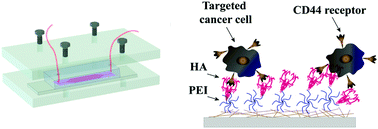Hyaluronic acid-functionalized electrospun PLGA nanofibers embedded in a microfluidic chip for cancer cell capture and culture†
Abstract
Circulating tumor cells (CTCs) are important markers of metastatic cancer. The isolation and detection of CTCs from peripheral blood provides valuable information for cancer diagnosis and precision medicine. However, cost-efficient targeted separation of CTCs of different origins with clinically significant specificity and efficiency remains a major challenge. In this study, a facile approach was developed to fabricate a thin sheet of hyaluronic acid (HA)-functionalized PLGA nanofibrous membrane and integrate it into a microfluidic chamber. The HA was covalently conjugated onto polyethyleneimine (PEI)-modified electrospun poly(lactic-co-glycolic acid) (PLGA) nanofibers. Different techniques were employed to characterize the resulted nanofibers. The results show that the CD44+ carcinoma of various origins (HeLa, KB, A549, and MCF-7 cells) could be selectively captured by the PLGA-PEI–HA nanofibers in the microfluidic platform. Importantly, the PLGA-PEI–HA nanofibrous membrane was more efficient to capture HeLa cancer cells under flowing conditions than in static dishes, and at a really low density (20 cells per mL). Furthermore, with constant media perfusion, the captured HeLa cells could grow on the nanofibrous membrane in the microchip for days without compromised cell viability. This is the first trial of using HA-functionalized electrospun nanofibers in a lab-chip device for cancer cell capture and culture. Compared to conventional CTC capture methods, the integration of inexpensive functional electrospun nanofibers and microfluidic technologies may expand the frontiers of using advanced nanomaterials in portable diagnostic applications.



 Please wait while we load your content...
Please wait while we load your content...